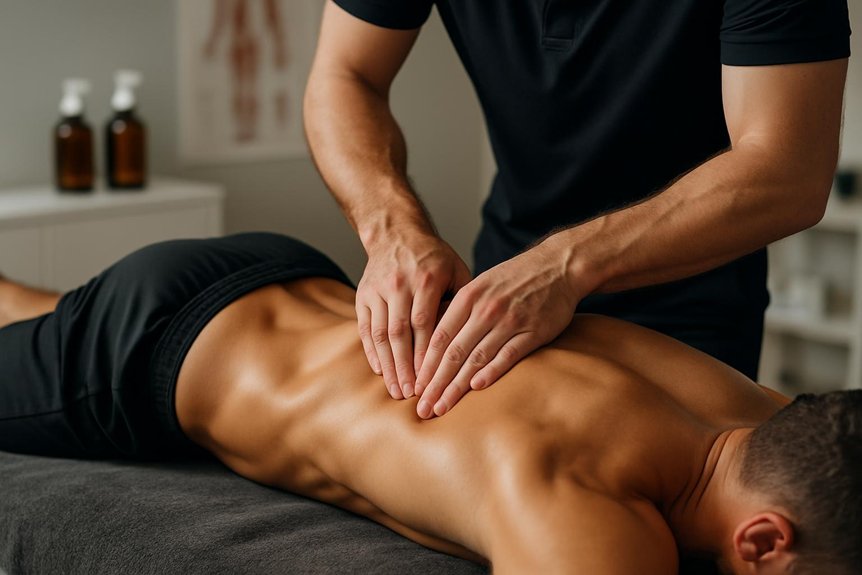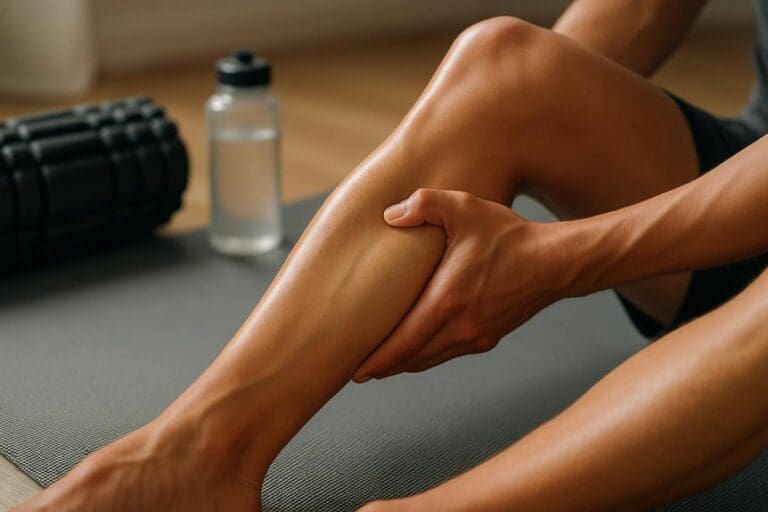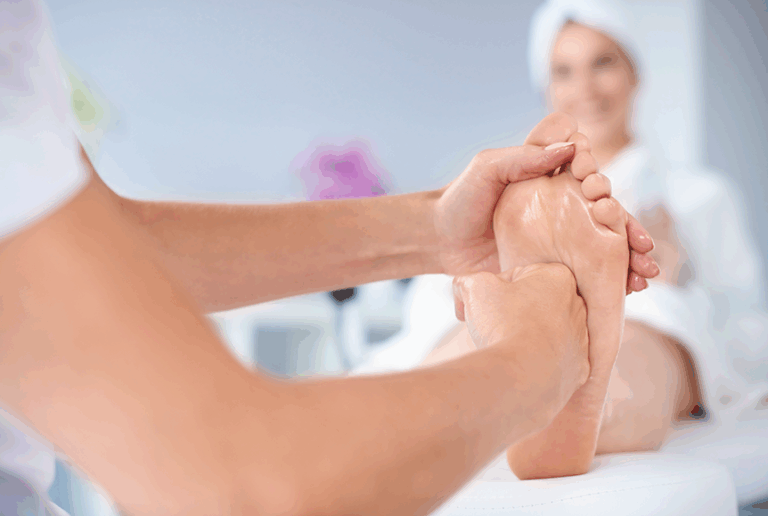Anterior pelvic tilt cannot be fully fixed during a single athletic massage session. Sports massage targets hypertonic muscles, relieves tension, and improves tissue quality, supporting the process of pelvic realignment. However, structural correction of anterior pelvic tilt requires ongoing interventions such as corrective exercises, postural retraining, and lifestyle adjustments. Athletic massage acts as a supportive modality that complements a broader, multifaceted approach. Further information clarifies realistic outcomes, integrated techniques, and strategies for sustained postural improvement.
Understanding Anterior Pelvic Tilt
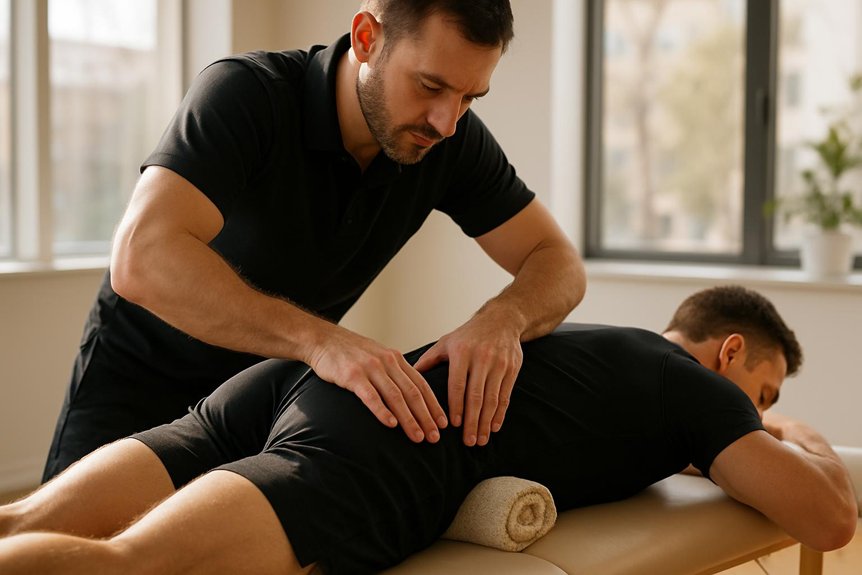
Anterior pelvic tilt is a postural deviation characterized by the forward rotation of the pelvis, which increases the curvature of the lower back and can lead to muscular imbalances and discomfort.
This condition is often observed in individuals with sedentary lifestyles or repetitive movement patterns. The altered pelvic position places increased tension on the lumbar spine and hip flexors, while often weakening the gluteal and abdominal muscles.
At Spa & Massage, therapists pay close attention to these biomechanical shifts during assessment, recognizing their impact on overall well-being.
Understanding anterior pelvic tilt is essential for addressing associated tension, pain, and reduced mobility.
Through detailed palpation and observation, therapists identify patterns of muscle tightness and adapt treatment strategies, ensuring every client receives targeted, restorative care for their unique postural needs.
Some therapeutic approaches, such as reflexology techniques, may also support the recovery process by stimulating specific points on the feet, hands, or ears to encourage relaxation and promote overall healing.
Common Causes and Symptoms
Anterior pelvic tilt frequently arises from muscle imbalances, particularly involving tight hip flexors and lower back muscles. This condition often coexists with weakened gluteal and abdominal groups.
Prolonged sedentary postural habits can exacerbate these imbalances, contributing to altered pelvic alignment.
Clients commonly report symptoms such as lower back discomfort, hip tightness, and sometimes radiating pain into the thighs.
Muscle Imbalances Involved
When the pelvis tilts forward excessively, a complex interplay of muscle imbalances is often at the root of the issue. Typically, shortened and overactive hip flexors—such as the iliopsoas and rectus femoris—pull the pelvis anteriorly.
Meanwhile, the lumbar erector spinae may become hypertonic, further accentuating the tilt. Conversely, the gluteus maximus and abdominal muscles, particularly the lower abdominals, tend to weaken and lengthen, compromising pelvic stability.
Clients may experience persistent lower back discomfort, hamstring tightness, and a sense of postural fatigue. At Spa & Massage, therapists are trained to identify these patterns through assessment and palpation.
They use targeted massage techniques to address specific muscle groups, foster neuromuscular balance, and support each client’s unique path toward improved alignment and comfort.
Postural Habits Impact
A forward pelvic tilt frequently develops as a consequence of prolonged postural patterns, particularly those associated with sedentary lifestyles or repetitive occupational demands. Extended periods of sitting, common in office environments, promote shortening of the hip flexors and weakening of the gluteal and abdominal musculature.
These adaptive changes gradually influence the alignment of the pelvis, often without immediate awareness. Clients may notice subtle symptoms such as stiffness in the lower back or a sense of imbalance during movement.
At Spa & Massage, therapists routinely observe these habitual patterns during assessments, guiding clients through education and targeted interventions. Recognising the influence of these daily habits is an essential step toward long-lasting postural improvements and helps inform the selection of tailored massage techniques that address both the muscular and behavioural components.
Typical Pain Patterns
Several distinct pain patterns are commonly associated with forward pelvic tilt, each reflecting underlying biomechanical imbalances.
Individuals frequently report localized discomfort in the lower back due to increased lumbar lordosis, which places sustained tension on paraspinal muscles and compresses lumbar vertebrae.
Secondary symptoms often include tightness or aching in the hip flexors and quadriceps, as these muscles remain chronically shortened.
Conversely, hamstrings and gluteal muscles may present with diffuse soreness or fatigue, caused by compensatory overactivity or persistent inhibition.
Anterior pelvic tilt can also contribute to referred pain radiating into the groin or anterior thigh.
At Spa & Massage, therapists are highly trained to identify these patterns through detailed assessment, supporting clients in understanding their symptoms and tailoring treatment to address both immediate pain and contributing postural factors.
The Role of Athletic Massage in Addressing Muscle Imbalances
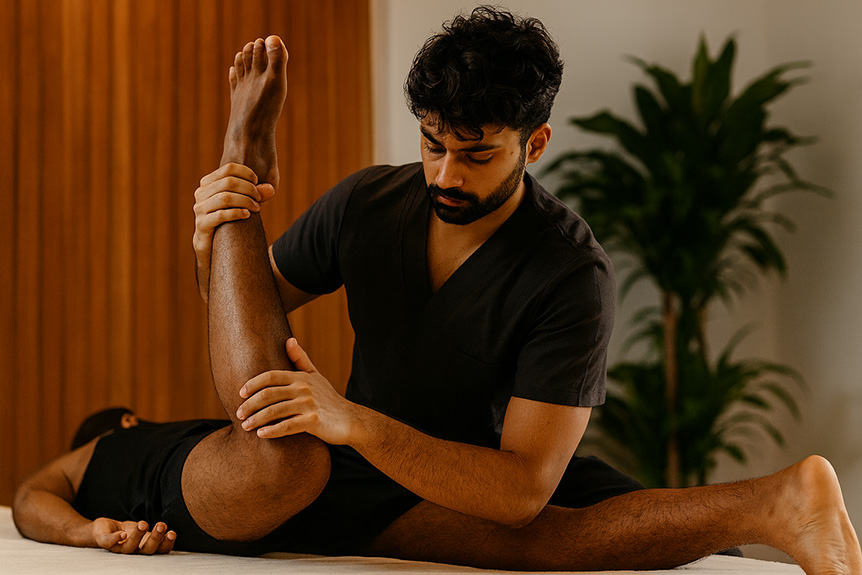
It plays a key role in addressing muscle imbalances associated with anterior pelvic tilt by applying targeted techniques to reduce tension in overactive muscle groups such as the hip flexors and lumbar extensors.
Evidence indicates that manual therapy can enhance flexibility and tissue quality, which supports clients’ postural realignment efforts when combined with corrective exercise.
At Spa & Massage, therapists tailor each session to address individual patterns of imbalance, promoting ideal musculoskeletal function and comfort.
Targeting Overactive Muscle Groups
When muscle imbalances such as anterior pelvic tilt develop, overactive muscle groups—including the hip flexors and lumbar erector spinae—can lead to altered postural alignment and restricted movement patterns.
At Spa & Massage, targeted athletic massage techniques are utilised to address these specific areas of tension and hyperactivity. By applying deep tissue pressure and myofascial release to the affected muscles, therapists aim to reduce excessive tone and improve tissue extensibility.
Evidence supports the use of manual therapy in diminishing neuromuscular overactivity, thereby aiding the restoration of more balanced muscle function.
Each session is tailored to the client’s unique presentation, ensuring that overactive groups are methodically released while safeguarding comfort.
This focused intervention can help relieve discomfort and pave the way for improved pelvic alignment over time.
Supporting Postural Realignment Efforts
Addressing overactive muscle groups is only one component in the management of anterior pelvic tilt; extensive postural realignment requires a systematic approach to correcting underlying muscle imbalances.
At Spa & Massage, therapists integrate athletic massage into broader strategies that support neuromuscular re-education and improved postural awareness.
Precision techniques target both hypertonic and inhibited musculature, encouraging a more balanced relationship between the pelvis, lumbar spine, and surrounding soft tissues.
Evidence suggests that targeted manual therapy, when combined with corrective exercise and ongoing client education, enhances proprioceptive feedback and supports long-term postural changes.
Clients are guided to actively participate in their realignment process, reinforcing the benefits of each session.
Ultimately, athletic massage acts as a crucial adjunct to thorough postural correction programmes, fostering sustainable, client-centred outcomes.
Techniques Used by Our Therapists for Pelvic Alignment
How do expert therapists at Spa & Massage approach pelvic alignment for clients experiencing anterior pelvic tilt? Their method is grounded in a precise assessment of muscular imbalances, particularly focusing on the hip flexors, lumbar extensors, gluteals, and abdominal muscles.
Therapists employ targeted deep tissue techniques, myofascial release, and active release therapy to address hypertonic muscles contributing to the anterior pelvic tilt.
Specialised stretching and neuromuscular facilitation are used to lengthen shortened tissues and stimulate underactive areas.
At Spa & Massage, therapists combine manual therapy with guided client education, ensuring tailored interventions based on each individual’s posture and movement patterns.
This client-focused approach aims to gently restore pelvic neutrality, enhance comfort, and cultivate a deeper sense of body awareness essential for lasting postural health.
What to Expect During Your Session
A typical athletic massage session at Spa & Massage begins with a thorough consultation to assess the client’s posture, specific muscular imbalances, and overall movement patterns. The therapist conducts a careful evaluation, paying close attention to anterior pelvic tilt indicators such as lumbar curvature, hip flexor tension, and gluteal activation.
During the massage, clinically proven techniques—such as myofascial release, trigger point therapy, and deep tissue manipulation—are applied to targeted muscle groups. Each intervention is tailored to the client’s needs, with a focus on restoring muscular balance and enhancing body awareness.
The environment is tranquil and supportive, encouraging relaxation and open communication. Throughout the session, clients are gently guided to notice changes in comfort, range of motion, and body alignment as therapeutic touch is delivered.
Complementary Stretches and Exercises Recommended
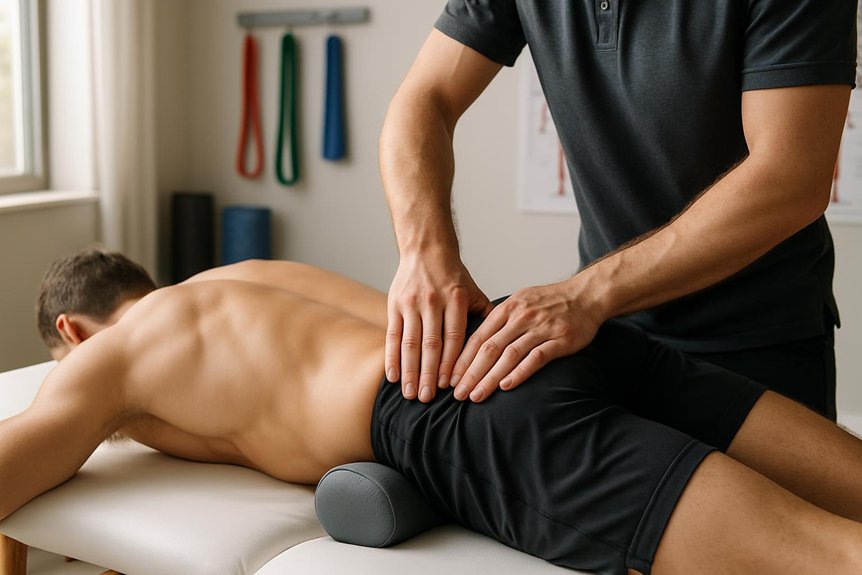
To optimise the therapeutic outcomes of massage for anterior pelvic tilt, targeted stretches and corrective exercises are integral components of the management process.
Spa & Massage therapists frequently recommend evidence-based movements such as hip flexor stretches, glute activation drills, and core stability exercises tailored to individual postural needs.
These interventions address both muscular tightness and weakness—common contributors to anterior pelvic tilt. For instance, extending the hip flexors and quadriceps can relieve excessive anterior tilt, while strengthening the abdominals and gluteal muscles promotes pelvic alignment.
Clients benefit from concise, personalised home exercise routines that are reviewed and adjusted during follow-up appointments. This collaborative approach ensures continuity of care and empowers clients to participate actively in their own postural rehabilitation between massage sessions.
Realistic Outcomes: What It Can and Cannot Achieve
While performance massage is a valuable modality for managing anterior pelvic tilt, it is essential to recognise its scope and limitations. It delivered by skilled therapists at Spa & Massage—effectively reduces myofascial tension, alleviates discomfort, and improves local circulation.
These benefits can temporarily enhance mobility and contribute to postural awareness. However, evidence indicates that massage alone cannot structurally correct anterior pelvic tilt, as the condition is influenced by muscle imbalances, habitual posture, and neuromuscular patterns.
Realistic outcomes include short-term relief, greater comfort, and a supportive environment for broader corrective strategies. Clients are encouraged to view athletic massage as a complementary intervention rather than a standalone solution.
For sustainable improvement, integrating massage with targeted exercise and lifestyle changes remains critical, as supported by current clinical guidelines.
Tips for Maintaining Pelvic Alignment After Your Treatment
Following a massage session targeting anterior pelvic tilt, the period immediately after treatment presents an opportunity to reinforce positive musculoskeletal changes. Spa & Massage therapists advise clients to integrate gentle stretching and core-strengthening exercises, as prescribed during their session, to support ideal pelvic alignment. Maintaining hydration and observing correct sitting and standing postures throughout daily activities are essential in preventing recurrence of compensatory muscle patterns.
Clients are encouraged to avoid prolonged static positions and to schedule regular movement breaks. At Spa & Massage clinics, therapists frequently recommend tailored aftercare routines, including the use of heat therapy or Epsom salt baths to reduce post-massage muscular tension.
Consistency in these practices enhances long-term results, supporting sustainable improvements in pelvic alignment and overall musculoskeletal health.
Conclusion
While this massage technique is a powerful tool in addressing the muscular imbalances linked to anterior pelvic tilt, it is not a magic wand that can instantly correct alignment. Evidence shows that meaningful improvement requires a holistic approach—combining targeted manual therapy, prescribed stretches, and ongoing lifestyle adjustments. By setting realistic expectations and following aftercare advice, clients can pave the way for lasting postural change and greater comfort in their daily lives.
